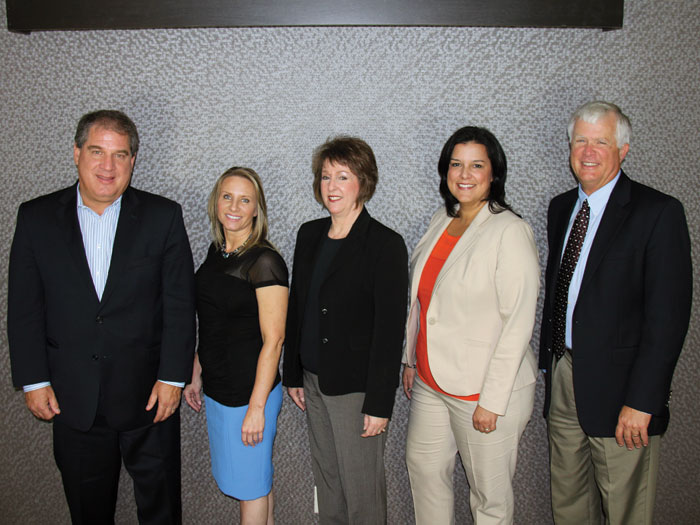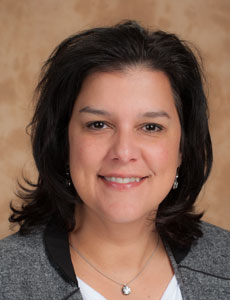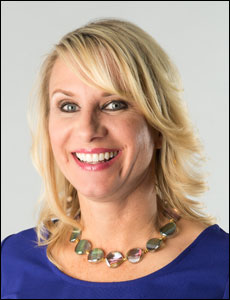Sponsored: Healthcare Solutions
Making Waves

FROM LEFT, Dan Reynolds, Heather Hornbrook, Michelle Weatherson, Elaine Vega and Jim Bankson.
California is famous in the workers’ compensation field for its cultural diversity and being a highly complex place to manage claims. It’s also well-known for its regulatory environment, in which sweeping legislative mandates strike the system like so many waves crashing on its famous beaches.
To get a first-hand account of the reforms and the innovations that make the California workers’ compensation environment so dynamic, Risk & Insurance® convened a roundtable discussion with four California-based claims executives in October.
The executives reported that the pace of regulatory change in California is as unceasing as advertised. But the discussion also picked up the threads of innovations at play in California, some of them borrowed from elsewhere, that are worth paying attention to.
According to Jim Bankson, president and founder of Northern Claims Management LLC, based in Santa Rosa, Calif., regulatory change in California happens so quickly one barely gets a chance to see how the last reform played out before the next one comes and wipes it away.
“It’s difficult to absorb the rules and regulations as they come out,” he said.
“At the company level it’s difficult to assimilate all of that and come up with a good working structure that both honors the law and provides our clients and injured workers the service that they need,” he said.
Another executive said those who manage claims in California have to be fast on their feet.
“We have to work really hard to stay out in front of these changes and make sure we have an appropriate solution to maximize the value of those changes,” said Elaine Vega, senior vice president, account management with Healthcare Solutions who is based outside of Sacramento.

Elaine Vega, Senior Vice President, Account Management, Healthcare Solutions
But participants agreed that reforms that have been given a chance to stick have improved conditions. Reforms in 2004 that established medical provider networks in California worked, they said.
“MPNs have been very successful and the outcomes continue to be both positive and cost-effective,” said Michelle Weatherson, director, Claims Medical and Regulatory Division, with California’s State Fund, the largest of the four remaining state funds in the United States.
The State Fund’s medical provider network of almost 5,000 physicians has its own inherent challenges due to its size, but it functions well overall, Weatherson said.
Drug Formulary
Weatherson and others based in California can now look forward to another significant regulatory reform. On Oct. 6, Gov. Jerry Brown signed into law a drug formulary for the state’s workers’ compensation system.
Prescription drug costs still comprise a significant piece of the ever rising medical expenditures in workers’ comp claims, with addictive painkillers leading the way.
The California participants expressed admiration for the formulary that has been in place for years in Texas, and hope California is just as successful at controlling costs and protecting workers’ rights to get the medications they need.
“What we’ve seen for our clients in Texas is a dramatic decline in opioid and narcotic use,” said Healthcare Solution’s Vega.
But there will still be the issue of legacy claims, much older claims where an injured worker that’s been off work for months, even years, has an entrenched dependence on painkillers.
That won’t be so easy to end, said Heather Hornbrook, executive vice president, workers’ compensation with the TPA Athens Administrators, based in Concord, Calif.
“You can’t just say, ‘OK, we’re not going to pay for those anymore, go ahead and detox in your bathroom,’ ” she said.
“At the company level it’s difficult to assimilate all of that and come up with a good working structure that both honors the law and provides our clients and injured workers the service that they need.”
— Jim Bankson, President and Founder, Northern Claims Management LLC
“You may still have to pay for an expensive detox problem and even then some folks won’t go,” she said.
Additional Reforms
The State Fund’s Weatherson pointed to another aspect of regulation from Texas that she hopes to see better enforced in California, mandatory electronic billing by providers.
California has had it on the books for 10 years, but it’s not enforced with the firmness there that it is in Texas, she said.
“They have great adoption and everybody lines up,” she said of the approach of regulators in Texas.
“That’s a huge cost savings and efficiency that the entire industry could realize if they would just line up behind it,” she said.
Another reform passed in California years ago that the panel agreed could be much better utilized is the state’s carve-out option for collective bargaining units.
It’s well known that claims from the dangerous work performed by police officers, firefighters and other emergency responders can be very costly to public sector budgets; especially if those emergency responders are part of a collective bargaining unit.
According to Northern Claims’ Bankson, the arrangement has to be initiated by the union but requires the participation and cooperation of a number of stakeholders.
Under such a carve-out agreement, an employer can sidestep the frictional expense and other possible downsides of an appearance in front of the Workers’ Compensation Appeals Board by coming to an agreement with an organized workforce on treatment parameters, return to work expectations and any number of the factors that can impact the outcome of a claim and a worker’s successful return to work.
“I think it could be a real boon for the right client with the right employee population,” Bankson said.
But like many of the reforms passed in California, it remains under-utilized, he said.
The Talent Question
When the latest round of health care and health care insurance reform was launched by the administration of President Barack Obama several years ago, experts told Risk & Insurance® that more people being insured under a group health plan or through a public exchange would translate to a scarcity of providers, especially in workers’ compensation.

Heather Hornbrook, Executive Vice President, Workers’ Compensation, Athens Administrators
That appears to be coming true in California and in other parts of the country.
“A lot of the doctors are moving out of the workers’ compensation arena and into private practice,” Athens Administrators’ Hornbrook said.
“We’re having a harder time getting appointments for people,” she said.
It’s a given that delays in treating workers’ comp cases means poorer outcomes and higher expenses.
Another facet of the talent question that bears close attention is the difficulty in attracting qualified talent to work as claims managers. As the California executives noted, claims management isn’t some form of glorified data entry.
It requires knowledge and engagement to get the best results. Perhaps most of all it requires someone who is passionate about getting injured workers healthy and back to work.
Hornbrook and her company Athens Administrators have hit on a solution, she said.
Recognizing that young people will communicate more easily with someone their own age, Athens has a younger member of their human resources department attend campus job fairs.
A key selling point among millennials, as the segment of the population born between 1982 and 2004 is known, is appealing to their desire for a higher purpose, a way to make the world a better place.
“Young people want to make a difference in the world and she can sell that,” Hornbrook said.
That initial recruitment effort is augmented by volunteer staff mentors, who guide younger talent in their evolution from assistants to full-fledged claims examiners.
“That’s worked very, very well,” Hornbrook said.
“We’re on our third round now of doing this and it has been very, very successful,” she said.
She added that despite an environment where headhunters are looking for claims management talent on a daily basis, Athens has lost none of its new recruits.
“We do the right thing. We’re restoring lives and that’s resonated with me for 26 years.”
— Michelle Weatherson, Director, Claims Medical and Regulatory Division, California State Fund
“They’ve stayed,” she said.
Athens Administrators also plans to put on a claims school in the first quarter of 2016.
Healthcare Solutions’ Vega said her company has also made a point of finding ways to promote talent and keep people engaged.
The company gives top assistants the necessary training to allow them to become senior examiners.
The appeal to a higher purpose isn’t something that‘s limited to the millennials, the State Fund’s Weatherson said.
“I have been with this organization for 26 years and when I came in the mantra was, ‘Do the right thing’,” she said.
“We do the right thing. We’re restoring lives and that’s resonated with me for 26 years,” she said.
“There is a noble purpose behind what we do.”
Opinions of the roundtable participants are the opinions of each individual contributor and are not necessarily reflective of their respective companies.
![]()
![]()
This article was produced by the R&I Brand Studio, a unit of the advertising department of Risk & Insurance, in collaboration with Healthcare Solutions. The editorial staff of Risk & Insurance had no role in its preparation.










